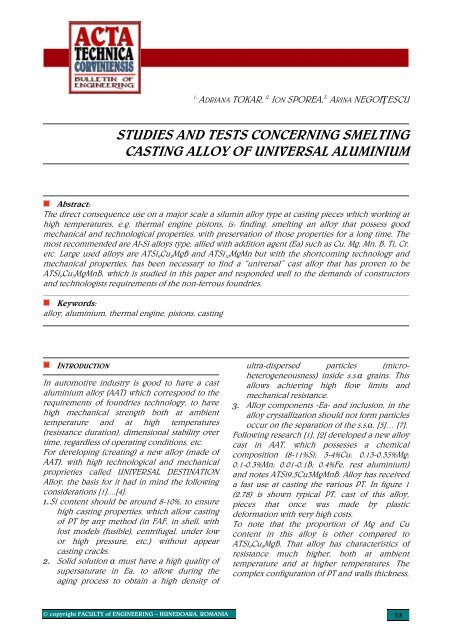ACTA TECHNICA CORVINIENSIS - Bulletin of Engineering
ACTA TECHNICA CORVINIENSIS - Bulletin of Engineering
ACTA TECHNICA CORVINIENSIS - Bulletin of Engineering
- No tags were found...
You also want an ePaper? Increase the reach of your titles
YUMPU automatically turns print PDFs into web optimized ePapers that Google loves.
1.ADRIANA TOKAR, 2. ION SPOREA, 3. ARINA NEGOIŢESCUSTUDIES AND TESTS CONCERNING SMELTINGCASTING ALLOY OF UNIVERSAL ALUMINIUMAbstract:The direct consequence use on a major scale a silumin alloy type at casting pieces which working athigh temperatures, e.g. thermal engine pistons, is: finding, smelting an alloy that possess goodmechanical and technological properties, with preservation <strong>of</strong> those properties for a long time. Themost recommended are Al-Si alloys type, allied with addition agent (Ea) such as Cu, Mg, Mn, B, Ti, Cr,etc. Large used alloys are ATSi 9 Cu 2 MgB and ATSi 10 MgMn but with the shortcoming technology andmechanical properties, has been necessary to find a “universal” cast alloy that has proven to beATSi 9 Cu 3 MgMnB, which is studied in this paper and responded well to the demands <strong>of</strong> constructorsand technologists requirements <strong>of</strong> the non-ferrous foundries.Keywords:alloy, aluminium, thermal engine, pistons, castingINTRODUCTIONIn automotive industry is good to have a castaluminium alloy (AAT) which correspond to therequirements <strong>of</strong> foundries technology, to havehigh mechanical strength both at ambienttemperature and at high temperatures(resistance duration), dimensional stability overtime, regardless <strong>of</strong> operating conditions, etc.For developing (creating) a new alloy (made <strong>of</strong>AAT), with high technological and mechanicalproprieties called UNIVERSAL DESTINATIONAlloy, the basis for it had in mind the followingconsiderations [1]....[4]:1. Si content should be around 8-10%, to ensurehigh casting properties, which allow casting<strong>of</strong> PT by any method (in FAF, in shell, withlost models (fusible), centrifugal, under lowor high pressure, etc.) without appearcasting cracks.2. Solid solution α must have a high quality <strong>of</strong>supersaturate in Ea, to allow during theaging process to obtain a high density <strong>of</strong>ultra-dispersed particles (microheterogeneousness)inside s.s.α grains. Thisallows achieving high flow limits andmechanical resistance.3. Alloy components -Ea- and inclusion, in thealloy crystallization should not form particlesoccur on the separation <strong>of</strong> the s.s.α. [5]… [7].Following research [1], [2] developed a new alloycast in AAT, which possesses a chemicalcomposition (8-11%Si; 3-4%Cu; 0.13-0.35%Mg;0.1-0.3%Mn; 0.01-0.1B; 0.4%Fe, rest aluminium)and notes ATSi9,5Cu3MgMnB. Alloy has receiveda fast use at casting the various PT. In figure 1(2.78) is shown typical PT, cast <strong>of</strong> this alloy,pieces that once was made by plasticdeformation with very high costs.To note that the proportion <strong>of</strong> Mg and Cucontent in this alloy is other compared toATSi 9 Cu 2 MgB. That alloy has characteristics <strong>of</strong>resistance much higher, both at ambienttemperature and at higher temperatures. Thecomplex configuration <strong>of</strong> PT and walls thickness,© copyright FACULTY <strong>of</strong> ENGINEERING – HUNEDOARA, ROMANIA 53
















